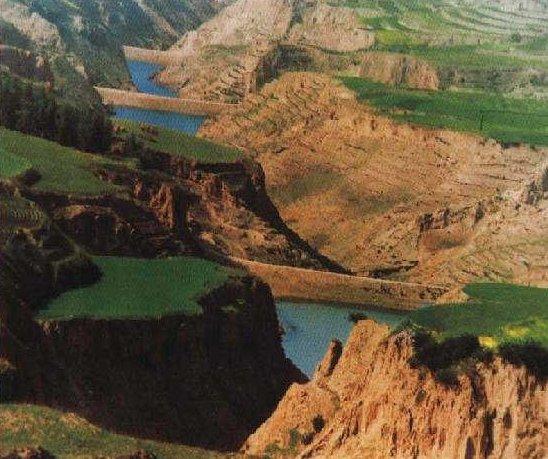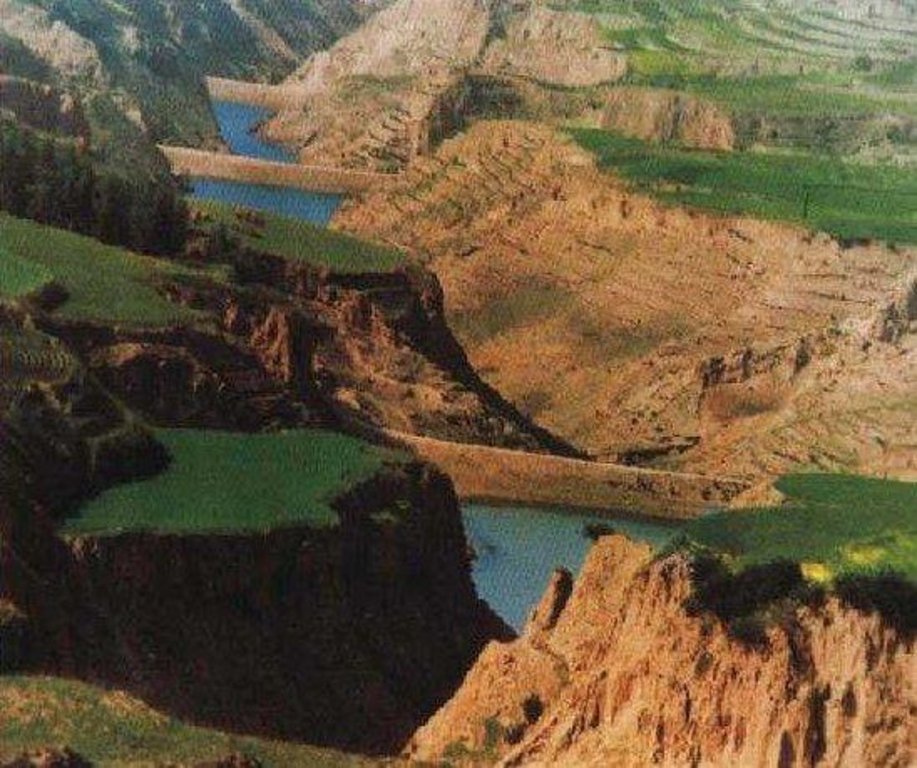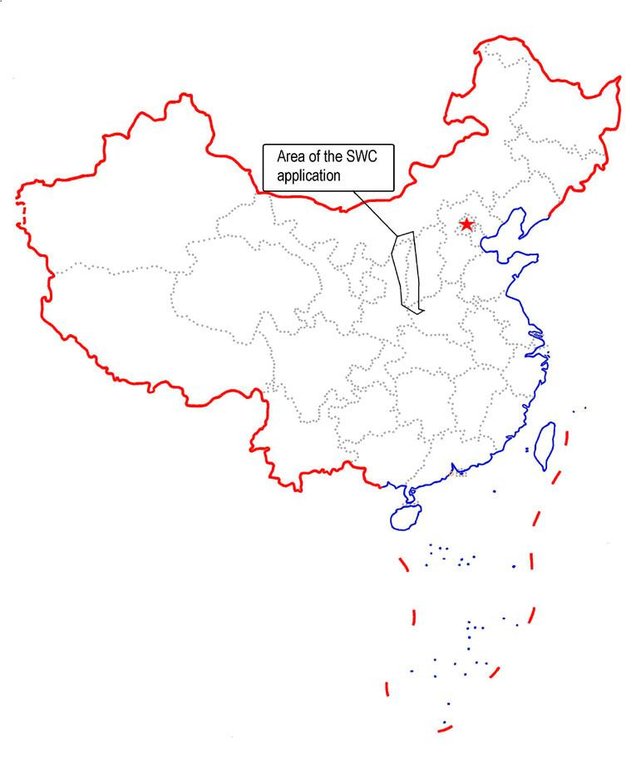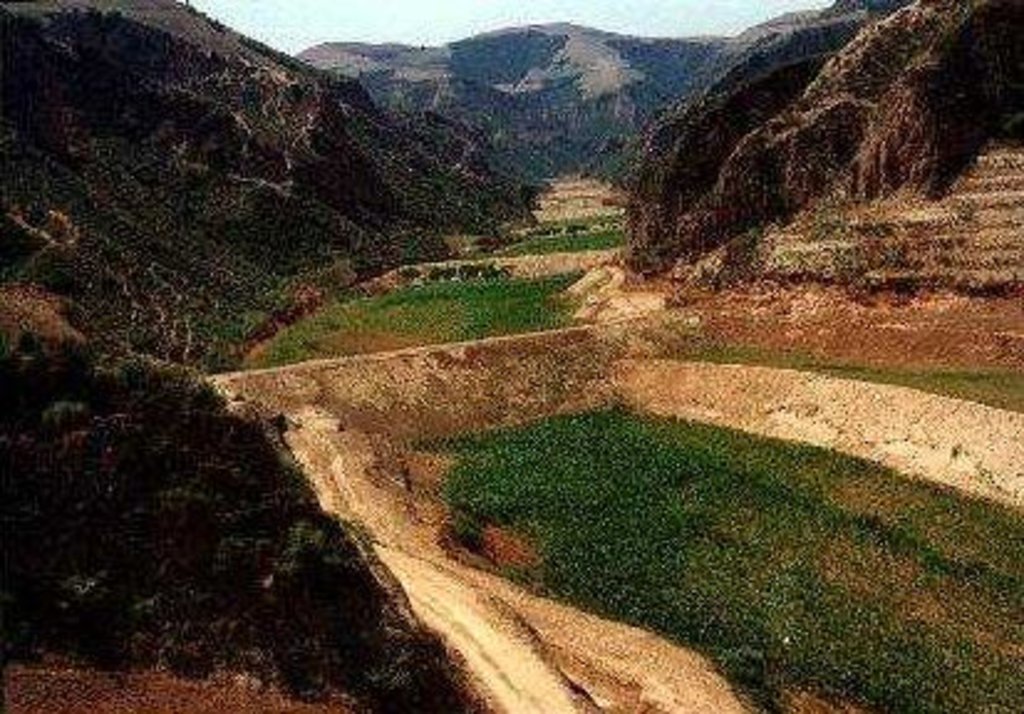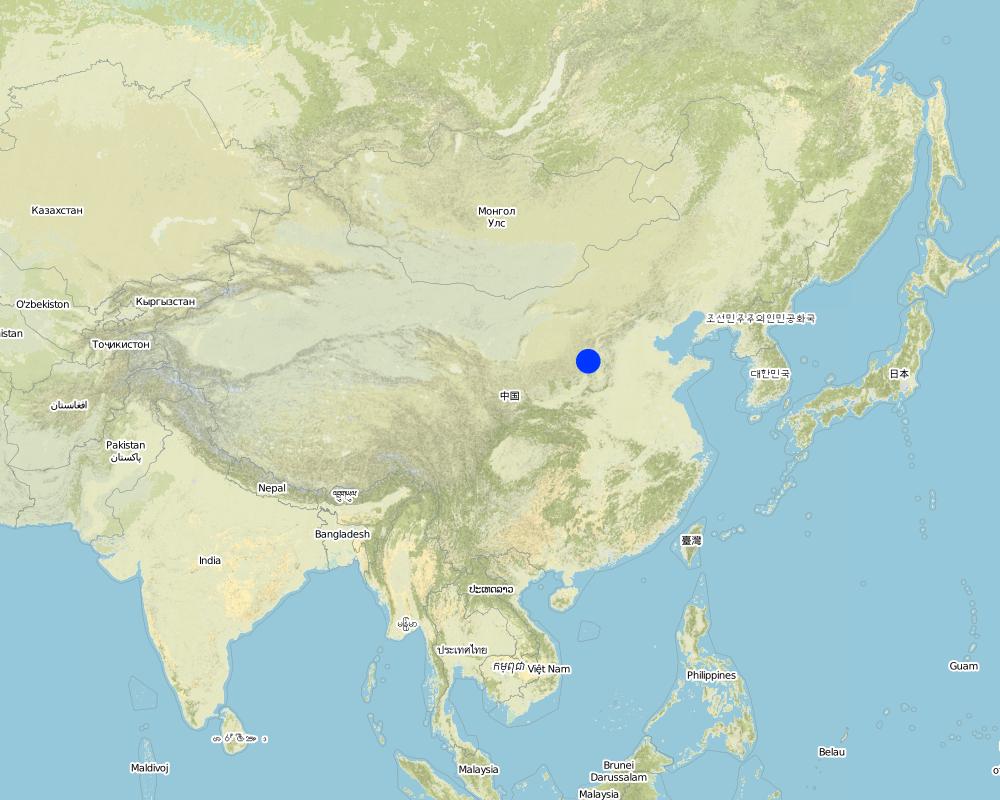Falling Water Dam [China]
- Criação:
- Atualização:
- Compilador/a: Yan ZHANG
- Editor: –
- Revisor: Laura Ebneter
approaches_2400 - China
Veja as seções
Expandir tudo Recolher tudo1. Informação geral
1.2 Detalhes do contato das pessoas capacitadas e instituições envolvidas na avaliação e documentação da abordagem
Especialista em GST:
Nome da(s) instituição(ões) que facilitou(ram) a documentação/avaliação da Abordagem (se relevante)
Department of Resources and Environmental Science, Beijing Normal University (Department of Resources and Environmental Science, Beijing Normal University) - China1.3 Condições em relação ao uso da informação documentada através de WOCAT
O/a compilador/a e a(s) pessoa(s) capacitada(s) aceitam as condições relativas ao uso de dados documentados através da WOCAT:
Sim
1.4 Referência ao(s) questionário(s) sobre tecnologias da GST
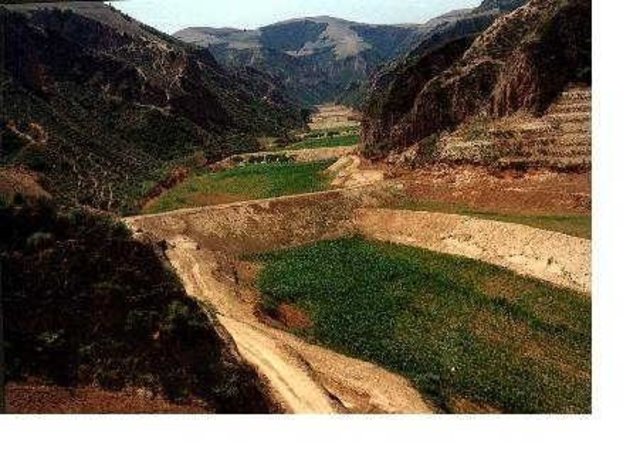
Auto-Flowing Slurry Dam [China]
Auto-flowing slurry dams is filled with dense slurry by water flow from upland to maintain eroded soil particles and runoff.
- Compilador/a: Yan ZHANG
2. Descrição da abordagem de GST
2.1 Descrição curta da abordagem
The falling water dams are widely built in the middle reach of the Yellow River, the typical dams are filled with dense slurry by water flow from upland. The approach is implemented mainly by government investment.
2.2 Descrição detalhada da abordagem
Descrição detalhada da abordagem:
Falling water filled dams distribute widely in the middle reaches of the Yellow River. They are used to store water, wrap sediment which results from soil and water loss. On the Loess Plateau, in addition to the conditions of deep gully and steep slope, earth above the top of the dams can be used to build dams. First, soil is loosed with squirt guns, explosion or manually digging. Then, water is pumped up to the loose earth so as to rush the soil down along transporting ditch, turning the soil into dense mud, to dams level surrounded by tamped banks. Under the press of gravity, the mud dehydrates, consolidates and becomes uniformly dense body of the dams. Compared with dams in other areas, the water power filled dams in the Yellow River basin are characterized by much denser mud, uniform particles and body texture, smaller transect of dams body, and wide applicability to soil materials such as sand soil, loess soil and weathering residue. The types of dams have widely applied to build middle and small reservoirs and silt arresters in the middle reaches of the Yellow River, playing an important role in agricultural production and reduction of sediment into the Yellow River.
2.3 Fotos da abordagem
2.5 País/região/locais onde a abordagem foi aplicada
País:
China
Região/Estado/Província:
Shanxi, Shaanxi, etc.
Map
×2.6 Datas de início e término da abordagem
Indique o ano de início:
1950
Ano de término (caso a abordagem não seja mais aplicada):
2005
2.7 Tipo de abordagem
- Tradicional/Indígena
2.8 Principais metas/objetivos da abordagem
The objectives of the approach are to control soil & water loss so as to reduce flood; to make more crop land.
The SLM Approach addressed the following problems: The main existing issues are unreasonable land use planning and low use rate; Lower standard of SWC design and poor quality in construction which would lead to flood danger; low administrative level and economic benefits.
2.9 Condição que propiciam ou inibem a implementação de tecnologia/tecnologias aplicada(s) segundo a abordagem
Disponibilidade/acesso a recursos e serviços financeiros
- Inibitivo
Only when government invests, the technology can be implemented
Treatment through the SLM Approach: investment
Quadro jurídico (posse de terra, direitos de uso da terra e da água)
- Propício
The existing land ownership, land use rights / water rights helped a little the approach implementation: Because land resources belongs to state and land user can lease the land.
3. Participação e papel das partes interessadas envolvidas
3.1 Partes interessadas envolvidas na abordagem e seus papéis
- Governo nacional (planejadores, responsáveis pelas decisões)
- Organização internacional
3.2 Envolvimento do usuários de terra/comunidades locais nas diferentes fases da abordagem
| Envolvimento do usuários de terra/comunidades locais | Especifique quem estava envolvido e descreva as atividades | |
|---|---|---|
| Iniciação/motivação | Automobilização | rapid/participatory rural appraisal; The approach is a traditional way to harvest water and wrap soils, SWC applied land users easy to understand and accept it if some subsidy being obtained. |
| Planejamento | Participativo | workshops/seminars; After a program granted, implementing agency and local communities working together. |
| Implementação | Apoio externo | responsibility for major steps; In practice, local communities are the major part to manager and carry out. |
| Monitoramento/avaliação | Passivo | interviews/questionnaires; When monitoring procedures are clear, the local communities could do this and evaluate. |
| Research | Participativo | Only can give some suggestions or questionnaire. |
3.4 Decisão sobre a seleção de tecnologia/tecnologias de GST
Especifique quem decidiu sobre a seleção de tecnologia/tecnologias a serem implementadas:
- Políticos/líderes
Explique:
Decisions on the choice of SLM Technology were made directive (top-down).
Decisions on the method of implementing the SLM Technology were made by by politicians / leaders (directive, top-down).
4. Suporte técnico, reforço das capacidades e gestão do conhecimento
4.1 Reforço das capacidades/ formação
Foi oferecida formação aos usuários da terra/outras partes interessadas?
Sim
Especifique quem foi capacitado:
- Usuários de terra
Tipo de formação:
- Agricultor para agricultor
- Áreas de demonstração
Assuntos abordados:
How to maintain and reinforce the dams
4.2 Serviço de consultoria
Os usuários de terra têm acesso a um serviço de consultoria?
Sim
Especifique se foi oferecido serviço de consultoria:
- Em centros permanentes
Descreva/comentários:
Name of method used for advisory service: Falling water dam show; Key elements: Selection of site for dam building, size of dam, materials and methods; 1) Mainly: projects own extension structure and agents, Partly: government's existing extension system 2) Mainly: projects own extension structure and agents, Partly: government's existing extension system; Extension staff: mainly government employees 3) Target groups for extension: land users; Activities: demonstration
Advisory service is quite adequate to ensure the continuation of land conservation activities; At each government level, there is a SWC office which is in charge of SWC activities including extension.
4.3 Fortalecimento da instituição (desenvolvimento organizacional)
As instituições foram fortalecidas ou estabelecidas através da abordagem?
- Sim, significativamente
Especifique a que nível (níveis) as instituições foram fortalecidas ou estabelecidas:
- Local
Especifique o tipo de apoio:
- Financeiro
- Reforço das capacidades/ formação
- Equipamento
4.4 Monitoramento e avaliação
Monitoramento e avaliação são partes da abordagem?
Sim
Comentários:
area treated aspects were ad hoc monitored through measurements
land users involved aspects were ad hoc monitored through measurements
There were few changes in the Approach as a result of monitoring and evaluation
4.5 Pesquisa
A pesquisa foi parte da abordagem?
Sim
Especifique os tópicos:
- Ecologia
- Tecnologia
Dê mais detalhes e indique quem realizou a pesquisa:
Pattern and standards for the dam design.
Research was carried out both on station and on-farm
5. Financiamento e apoio material externo
5.1 Orçamento anual para o componente de GST da abordagem
Caso o orçamento exato seja desconhecido, indique a faixa:
- > 1.000.000
Comentários (p. ex. principais fontes de recursos/principais doadores):
Approach costs were met by the following donors: government (national - The central government): 85.0%; local community / land user(s) (Village committee): 5.0%; other (World Bank): 10.0%
5.3 Subsídios para entradas específicas (incluindo mão-de-obra)
- Equipamento
| Especifique quais entradas foram subsidiadas | Em que medida | Especifique os subsídios |
|---|---|---|
| Maquinário | Totalmente financiado | subsidy |
- Infraestrutura
| Especifique quais entradas foram subsidiadas | Em que medida | Especifique os subsídios |
|---|---|---|
| community infrastructure | Totalmente financiado | financed by government |
Se a mão-de-obra pelos usuários da terra foi uma entrada substancial, isso foi:
- Voluntário
Comentários:
If managed by administrative way, land users' input are mainly voluntary, if through a project, usually paid in cash.
5.4 Crédito
Foi concedido crédito segundo a abordagem para atividades de GST?
Sim
Especifique as condições (taxa de juros, reembolso, etc):
Interest rate charged: 4.0%; repayment conditions: After 4 or 5 years when SWC produces benefits, loaner should return.
Interest was lower than market rate.
6. Análise de impactos e declarações finais
6.1 Impactos da abordagem
A abordagem auxiliou os usuários da terra a implementar e manter as tecnologias de GST?
- Não
- Sim, pouco
- Sim, moderadamente
- Sim, significativamente
They can harvest water and irrigate crops in dry seasons. Meanwhile, more crop land area is made.
A abordagem melhorou as questões de posse de terra/diretos do usuário que inibiam a implementação das tecnologias de GST?
- Não
- Sim, pouco
- Sim, moderadamente
- Sim, significativamente
The policies of land contract distribute land to individuals so that land users who involved in SWC activities need to be organized together for implementation of the SWC. The organization need much time and hard work. The problem is likely to be overcome in the near future. Administrative management can adjust and assort with this issue.
Did other land users / projects adopt the Approach?
- Não
- Sim, pouco
- Sim, moderadamente
- Sim, significativamente
6.3 Atividades de sustentabilidade de abordagem
Os usuários da terra podem manter o que foi implementado através da abordagem (sem apoio externo)?
- Sim
6.4 Pontos fortes/vantagens da abordagem
| Pontos fortes/vantagens/oportunidades na visão do usuário da terra |
|---|
| Raising crop production and return (How to sustain/ enhance this strength: applying fertilizers as possible as can) |
| water can be irrigated in dry seasons and drinks both for cattle and man (How to sustain/ enhance this strength: maintaining and repairing if needed.) |
| Pontos fortes/vantagens/oportunidades na visão do/a compilador/a ou de outra pessoa capacitada |
|---|
| Storing water (How to sustain/ enhance this strength: reducing vapour and leak as possible as can) |
| Enlarge cropland and raising yield (How to sustain/ enhance this strength: shifting food crops to cash crops) |
| reducing flooding (How to sustain/ enhance this strength: reinforce the dams timely) |
6.5 Pontos fracos, desvantagens da tecnologia e formas de superá-los
| Pontos fracos/desvantagens/riscos na visão do usuário da terra | Como eles podem ser superados? |
|---|---|
| Costly and frenquently reinforce |
| Pontos fracos/vantagens/riscos na visão do/a compilador/a ou de outra pessoa capacitada | Como eles podem ser superados? |
|---|---|
| The dams' quality are not high | standardization for design and construction |
7. Referências e links
7.1 Métodos/fontes de informação
- visitas de campo, pesquisas de campo
- entrevistas com usuários de terras
7.2 Referências às publicações disponíveis
Título, autor, ano, ISBN:
Special Planning Of Soil And Water Conservation in Xinzhou Region , Shanxi Province, 1986-1990
Disponível de onde? Custos?
Library of the Resource and Environmental Department, Beijing Normal University.
Título, autor, ano, ISBN:
How to design the dry masonry dam in the Hanjiachuan watershed. Tianyuzhu, Wangzuliang. Beijing. Water conservation in Beijing, 2000
Disponível de onde? Custos?
Library of the Resource and Environmental Department, Beijing Normal University.
Links e módulos
Expandir tudo Recolher tudoLinks

Auto-Flowing Slurry Dam [China]
Auto-flowing slurry dams is filled with dense slurry by water flow from upland to maintain eroded soil particles and runoff.
- Compilador/a: Yan ZHANG
Módulos
Não há módulos


